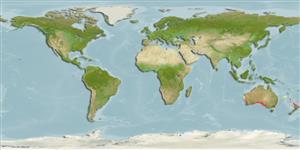Environment: milieu / climate zone / depth range / distribution range
Ökologie
seewasser demersal; tiefenbereich 0 - 360 m (Ref. 9563), usually 0 - 200 m (Ref. 6390). Subtropical; 22°S - 39°S
Eastern Indian Ocean: southern Australia, from Western Australia to New South Wales. The species is considered to be endemic to Australia, although a single specimen has been reported from New Zealand (Ref. 30464).
Length at first maturity / Size / Gewicht / Alter
Maturity: Lm ?, range 37 - ? cm
Max length : 100.0 cm TL Männchen/unbestimmt; (Ref. 9563); max. veröff. Gewicht: 3.5 kg (Ref. 27296); max. veröff. Alter: 9 Jahre (Ref. 30466)
Rückenflossenstacheln (insgesamt) : 2; Rückenflossenweichstrahlen (insgesamt) : 30 - 36; Afterflossenstacheln: 0; Afterflossenweichstrahlen: 30 - 34. Whitish, pale yellowish brown, pale greyish brown or reddish, often with four brown stripes along sides; second dorsal and anal fins yellow; caudal fin rays yellowish brown, intervening membranes dusky. Pelvic fins rudimentary (Ref. 33839).
Adults are found on the continental shelf and slope, while juveniles school seasonally in inshore waters (Ref. 9563). Juvenile ocean jackets have been caught in seagrass, over bare sand and on rocky reefs (Ref. 6390). Adults however, tend to be absent from seagrass areas (Ref. 6390). Are carnivorous, feeding mainly on salps. Other food items in the diet include gastropod mollusks, crustaceans and fish (Ref. 30465). Sold as fresh trunks (Ref. 6390).
Assumed nonguarder because of high fecundity (RF).
May, J.L. and J.G.H. Maxwell, 1986. Trawl fish from temperate waters of Australia. CSIRO Division of Fisheries Research, Tasmania. 492 p. (Ref. 9563)
IUCN Rote Liste Status (Ref. 130435: Version 2024-1)
Bedrohung für Menschen
Harmless
Nutzung durch Menschen
Fischereien: kommerziell
Tools
Zusatzinformationen
Download XML
Internet Quellen
Estimates based on models
Preferred temperature (Ref.
123201): 15.3 - 21.2, mean 17.9 °C (based on 422 cells).
Phylogenetic diversity index (Ref.
82804): PD
50 = 1.0000 [Uniqueness, from 0.5 = low to 2.0 = high].
Bayesian length-weight: a=0.01122 (0.00653 - 0.01928), b=2.84 (2.69 - 2.99), in cm total length, based on LWR estimates for this species & (Sub)family-body (Ref.
93245).
Trophic level (Ref.
69278): 3.7 ±0.60 se; based on food items.
Generation time: 6.9 ( na - na) years. Estimated as median ln(3)/K based on 1
growth studies.
Widerstandsfähigkeit (Ref.
120179): mittel, Verdopplung der Population dauert 1,4 - 4,4 Jahre. (tm=2-4; tmax=9; Fec=700,000).
Fishing Vulnerability (Ref.
59153): High vulnerability (56 of 100).
Nutrients (Ref.
124155): Calcium = 33.6 [12.7, 95.1] mg/100g; Iron = 0.875 [0.402, 2.209] mg/100g; Protein = 18.4 [16.2, 20.6] %; Omega3 = 0.27 [0.12, 0.57] g/100g; Selenium = 49 [20, 120] μg/100g; VitaminA = 5.33 [1.45, 19.80] μg/100g; Zinc = 0.488 [0.308, 0.791] mg/100g (wet weight);
